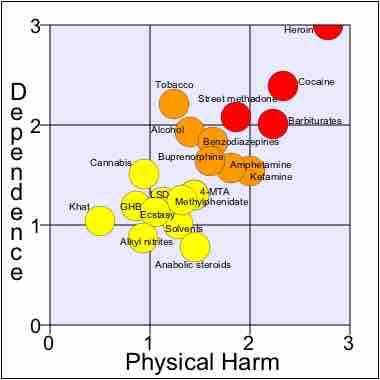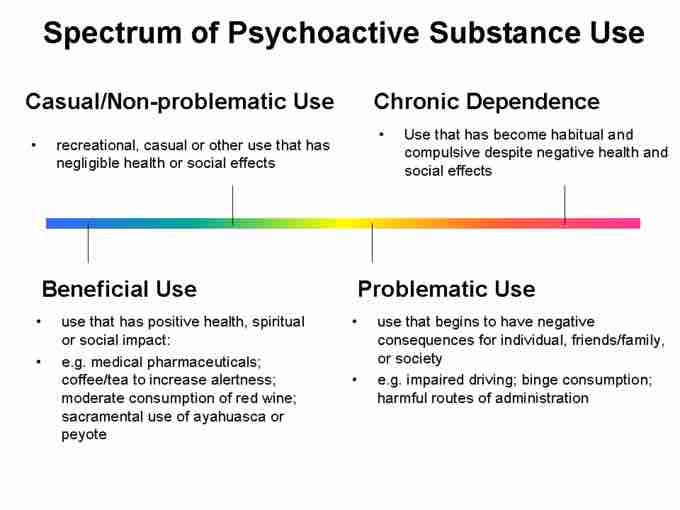Substance abuse is the habitual and recreational use of an addictive agent (drug) that is consumed in dangerous amounts or dangerous situations. The psychoactive effects of drug abuse occur when the drugs impact the levels of neurotransmitters in the brain that control normal mental and physical functioning. For instance, chronic drug abuse can negatively impact memory functioning, impulse control, and reaction time; it can also increase the risk for heart disease, cancer, liver failure, etc. Individuals who use substances to the point of dependence are at even greater risk for physical health problems, or even overdose, due to development of tolerance, or needing to use more and more of the substance to obtain the desired effect. Withdrawal symptoms are equally dangerous: these are the uncomfortable and sometimes fatal physical symptoms that occur when the drug is absent from the body.

Substance abuse chart
This chart compares the relative danger of particular substances based on the dependence level developed and the potential physical harm to the user and others. Heroin, with an extremely high dependence and high potential for physical harm, is an extremely dangerous substance.
Substance abuse can have a variety of detrimental effects on the mind and body of the user.
Psychological Effects of Substance Abuse
Substance abuse can have a notable adverse effect on mood, increase the risk of mental illness, and exacerbate preexisting symptoms. Some people turn to substances to self-medicate for disorders like depression, anxiety, or bipolar disorder, only to find that substance use, while diminishing psychological distress in the short-term, only exacerbates the symptoms in the long run. Even worse is that the negative psychological side effects of substance use put abusers at a increased risk of suicide. Some substances can induce mood, anxiety, or psychotic symptoms, and these symptoms may persist even after the effects of the drug have subsided. In some cases hallucinogens like mescaline and peyote have triggered psychotic behaviors that last for years after use.
Physical Effects of Substance Abuse
In addition to adversely altering the mental health of users, substance abuse can have a significant and long-lasting impact on the body. Short term effects can manifest in the form of drowsiness and changes in breathing (slow breathing or hyperventilation), abdominal cramping, diarrhea, irregular heart rate, and even strokes. In the long term, users may suffer from dental and gum deterioration, sleep disorders, a variety of respiratory problems, and damage to the brain, kidneys, and liver. Users may also lose their appetite and their ability to regulate body temperature.
Substance abuse can also lead to secondary physical effects. A user's mental state may cause them to take unnecessary risks or engage in self harm or aggressive behavior toward others. Another array of secondary (physical) effects manifests if the user stops taking regular doses of the substance. This is often called "withdrawal" and can result in uncontrollable shaking and convulsions, extreme physical pain, and even dehydration, since users in this state may be unable to consume food and water. Yet another set of secondary effects stems from the unhealthy conditions in which substances are often consumed: for instance, sharing or using unsterilized needles can cause users to contract AIDS, hepatitis, or other diseases.

Spectrum of substance use
Substance use falls on a spectrum ranging from beneficial, prescribed and monitored use of prescription drugs to the recreational use, abuse, or dependence on illicit drugs.